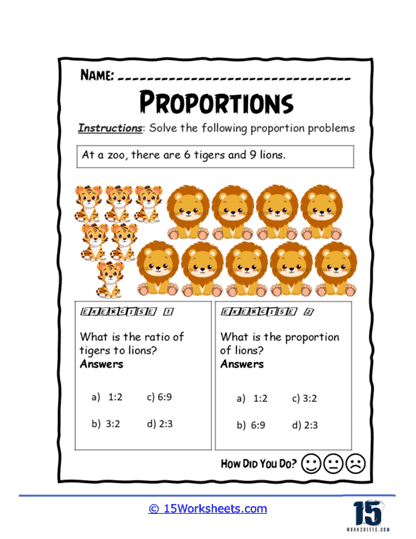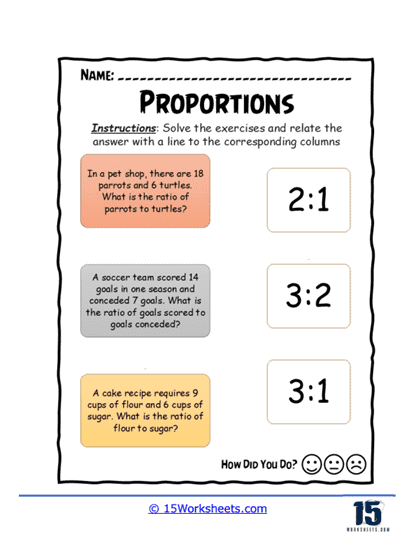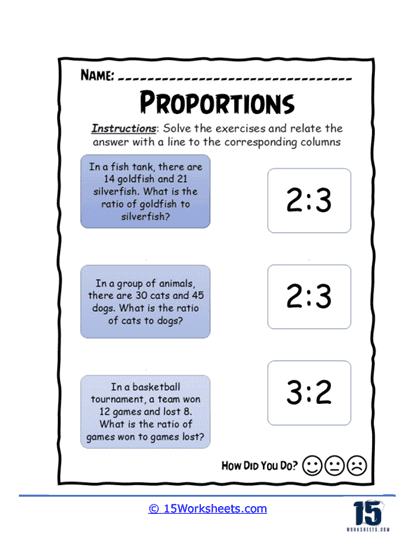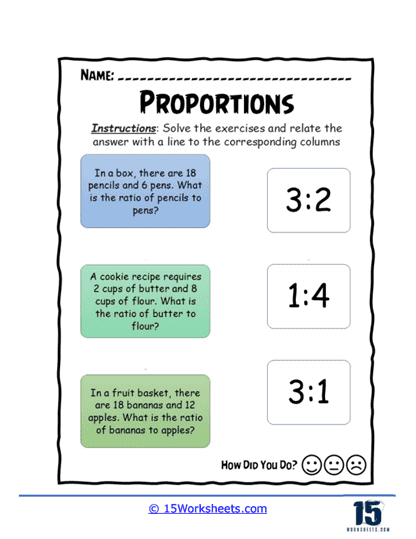Proportions Worksheets
All About These 15 Worksheets
Our proportions worksheets will help students develop their understanding of proportions, ratios, and their applications in real-world scenarios. These worksheets provide practice exercises that require students to solve proportion-related problems, reinforcing mathematical concepts that are fundamental to many areas of study, including algebra, geometry, science, and everyday problem-solving. By working through these worksheets, students can build essential skills in proportional reasoning, which has broad applications across various fields.
What Are Proportions?
Before diving into the specifics of proportion worksheets, it’s essential to define what proportions are. A proportion is a statement that two ratios or fractions are equivalent. For example, if the ratio of apples to oranges in a basket is 2:3, and another basket has the same ratio of apples to oranges, regardless of the total number of fruits, the two ratios are said to be in proportion. The concept of proportions is used to solve problems involving scaling, unit conversions, map reading, recipes, and many other real-life situations.
Types of Problems
Proportions worksheets come in various formats, depending on the level of the students and the specific mathematical concepts being emphasized. Below are the types of exercises and topics one would expect to encounter on these worksheets:
Basic Usage
These problems typically introduce students to the concept of ratios, followed by simple proportions. For example, a worksheet might present a ratio such as 4:5 and ask the student to determine an equivalent ratio given one missing term, such as 8. The goal is for students to understand the relationship between the numbers and solve for the unknown.
Another common type of problem in this section is asking students to identify whether two given ratios form a proportion. This involves simplifying or cross-multiplying ratios to verify their equality.
Word Problems
Word problems are an essential part of proportion worksheets, as they bridge the gap between abstract numbers and practical situations. Students are asked to apply their understanding of proportions to solve real-world problems. For example, they might be asked how much paint is needed to cover a wall given a ratio of paint to square footage or to calculate how long it will take to travel a certain distance at a consistent speed.
These word problems require students to carefully read and interpret the scenario, set up a proportion based on the information provided, and solve for the unknown. Word problems develop critical thinking and comprehension skills, as students must figure out which numbers correspond to the appropriate ratios and how to manipulate them.
Scale Factor and Maps
Proportions worksheets often include exercises related to scale drawings and maps. A scale drawing represents an object or area in a proportionally reduced or enlarged size. For example, a map might show a scale of 1 inch representing 10 miles, and students would be tasked with determining the actual distance between two cities based on their separation on the map.
These problems help students understand how proportions are used in geography, architecture, and design, making them applicable to careers in fields like engineering, urban planning, and cartography.
Unit Conversions
Many proportion worksheets incorporate problems that involve converting units of measurement. For instance, students might be asked to convert kilometers to miles, inches to feet, or grams to kilograms using given conversion factors. By setting up a proportion between the known conversion factor and the quantities involved, students learn to handle unit conversions accurately and efficiently.
This skill is particularly useful in science, where students often encounter measurements in different units, as well as in fields such as cooking, carpentry, and travel planning.
Percentages and Proportions
Some proportion worksheets include exercises on calculating percentages. Since percentages are essentially ratios where the total is 100, students can use proportions to solve for unknown values in percentage problems. For instance, they might be asked to find what percent 25 is of 200, or how much money someone will save if a 20% discount is applied to a purchase.
These exercises reinforce the connection between percentages and proportions, allowing students to apply this understanding in everyday activities like shopping, budgeting, and analyzing data.
Cross-Multiplication Problems
A common technique taught in proportions worksheets is cross-multiplication, which is used to solve proportions more quickly and efficiently. This method involves multiplying the numerator of one ratio by the denominator of the other ratio and setting the two products equal to each other. Cross-multiplication is particularly useful for solving complex proportion problems where an unknown variable needs to be isolated.
Worksheets that focus on cross-multiplication often present increasingly difficult problems, helping students solidify their mastery of this technique. It prepares them for more advanced mathematical concepts, such as solving rational equations in algebra.
Graphing Proportions
Some worksheets incorporate graphing exercises where students plot proportional relationships on a coordinate plane. These problems teach students to recognize linear relationships, as a proportional relationship between two variables will produce a straight line that passes through the origin. Students are asked to identify key points, such as the slope, and analyze how changes in one variable affect the other.
These exercises help students visualize proportions, making it easier to understand how variables interact in real-world contexts. This is particularly helpful in science, where proportional relationships often appear in experiments involving speed, density, or pressure.
Inverse Proportions
In more advanced worksheets, students may encounter problems involving inverse proportions, where an increase in one quantity leads to a proportional decrease in another. For example, if the speed of a car increases, the time it takes to travel a certain distance decreases proportionally. Students learn to set up equations that represent inverse relationships and solve for unknowns.
Understanding inverse proportions is critical in fields like physics, where concepts such as force, pressure, and velocity often involve inversely proportional relationships.
What is the Difference Between a Ratio and Proportion?
A ratio is a comparison of two or more numbers, values, or quantities, expressing how much of one entity exists in relation to another. Ratios are typically written in the form “a to b” or as a fraction, a/b. Ratios give a quantitative measure of the relationship between the values being compared. For example, if a recipe calls for 3 cups of flour for every 2 cups of sugar, the ratio of flour to sugar is 3:2. This ratio indicates how much flour is used relative to the sugar, but it does not tell us the overall quantities of flour and sugar involved.
On the other hand, a proportion is an equation that states that two ratios are equal. Proportions are used to describe how different parts relate to each other or how two ratios compare across different sets. It answers the question, “Are these two ratios equivalent?” For instance, if we know that the ratio of flour to sugar is 3:2 in one batch of a recipe and we double both quantities in a larger batch (6 cups of flour and 4 cups of sugar), we say that the two ratios, 3:2 and 6:4, form a proportion because they represent the same relationship. The key aspect of a proportion is equality between two or more ratios.
When to Use a Ratio vs. a Proportion
When deciding whether to use a ratio or a proportion, it’s important to understand the differences in their applications. A ratio is most useful when you are simply comparing two values without needing to scale or compare them with another ratio. For instance, if you are looking at the ratio of students to teachers in a classroom, such as 30:1, this comparison tells you how many students there are per teacher. The focus is solely on the relationship between the two values in this specific instance, and you’re not necessarily concerned with how this ratio applies to other classrooms or whether it holds in different scenarios.
On the other hand, a proportion is used when you need to prove or establish the equality between two ratios, especially when scaling is involved. For example, if you’re organizing a party and a recipe calls for 2 pizzas for every 5 people, but you need to feed 20 people, a proportion helps you maintain the same ratio as you adjust for the larger group. In this case, you would set up a proportion like 2/5 = x/20, which allows you to solve for the unknown (x) and find that you’ll need 8 pizzas. Proportions are essential when scaling quantities to fit different scenarios while maintaining the same relative balance between the compared values.















